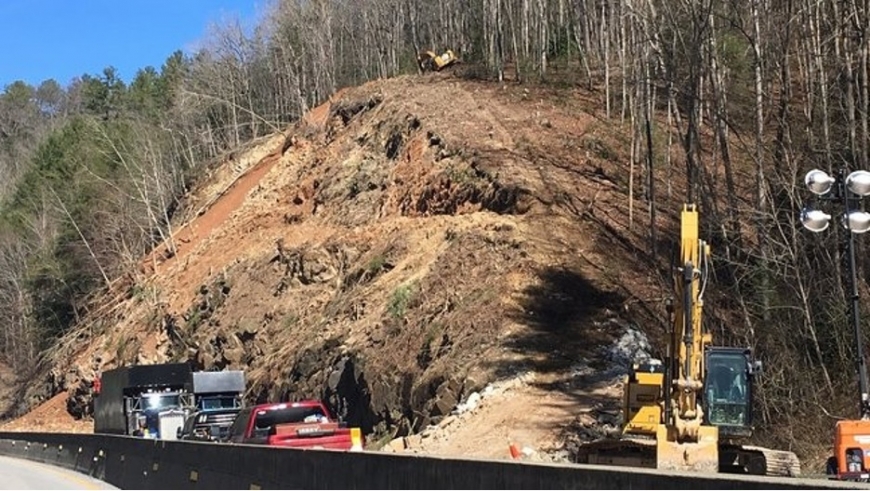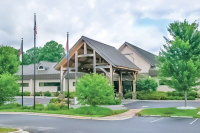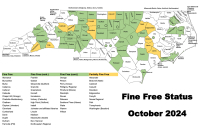Come Hell or High Water, Asheville Is Climate 'Winner'

By Tom Fiedler | Asheville Watchdog — Back in 2006, when Scott Shuford was Asheville’s planning director, he reluctantly accepted a friend’s invitation to attend a meeting about the impact of climate change on local governments.
“I didn’t see how a two-degree temperature change could affect the community,” he recalled, referring to the predicted rise in earth temperatures in years to come. “But I agreed to attend, thinking it would only be about 15 minutes.
“After about an hour-and-a-half I came out of the meeting drenched in sweat.”
All the plans he had drafted up to that day suddenly seemed to have overlooked an unsettled future fraught with unanticipated challenges. Those two degrees of temperature change meant greater threats of weather extremes — of torrential rains, devastating floods, and landslides, and of their opposites, extended drought and wildfire.
“We weren’t ready,” Shuford said of Asheville’s infrastructure at the time. “We still had storm water pipes made of oak trees from 100 years ago.”
But none of those natural threats holds the potential to forever alter Asheville and its surrounding counties as much as a different one: climate refugees.
Asheville Booms as “Safe City”
“Asheville is becoming known as a ‘safe city’,” said Mary Spivey, community manager of The Collider, an organization for local professionals engaged in climate services. “Many people are starting to migrate here and are using that term. Many others are claiming a spot so that they may come here when they feel they need to.”
By “many people” Spivey doesn’t mean a few. This region has long attracted residents seeking to enjoy its temperate, year-round climate, its natural beauty, its recreational amenities, its cultural delights, its open spaces and — until recently — its relatively moderate living costs. As its reputation spread, occasional visitors became residents and the population boomed.
Between 2010 and 2019, according to U.S. Census Bureau estimates, Buncombe County’s population rose more than 10 percent to more than 260,000. This percentage was more than double that of the state’s population growth and nearly 10 times the national percentage.
But this boom largely predated the public’s growing awareness of climate change and its visible impacts, and it came when the highest levels of government tried to deny or downplay the reality. President Biden has already ranked the need to address climate change at the forefront of his agenda, which is certain to accelerate public concerns.
Some forecasts predict that greater Asheville’s population will balloon by another 50,000 people by 2080.
Heading for the High Ground
Florida State University sociologist Mathew Hauer estimates that many of these climate migrants will come from such coastal cities as Miami, New Orleans, Charleston, Savannah, New York City, and Boston. The reason: Sea levels by the end of this century are expected to rise between one and eight feet — enough to displace as many as 13 million coastal dwellers, according to Hauer’s calculations.
That total would more than double even the so-called Great Migration of Blacks fleeing racial bigotry in the south in the first half of the 20th century.
(Map: Image credit: NOAA. Caption: By 2100 coastal communities could experience sea-levels up to 8 feet higher than in 2000. Some analysts predict 13 million people could be displaced and likely to migrate to “safe cities.”)
Others will come to the Western North Carolina mountains from inland parts of the deep south to escape increasingly suffocating summer temperatures, which may climb above current daily averages by as much as 10 degrees during this century, some scientists say. Experts say the coronavirus pandemic may accelerate this migration because many people have adapted to working over the internet, no longer tethered to a physical office.
“We know that people have migrated because of climate since, well, since there were people,” said Shuford, who is now with CASEconsultants International, an Asheville firm that advises governments, technical groups and corporations on dealing with climate change.
“Now you have the ability to work where you live rather than having to live where you work,” he continued. “So how many times are you going to see your house in California burn until you’re going to decide to move to a place where that’s not an issue?”
Jeffrey Kaplan, director of the VentureAsheville initiative that seeks to attract high-tech start-ups to the region, said many of the recent inquiries he’s handled come from entrepreneurs from the west coast and Colorado, where apocalyptic wildfires have become an ever-present threat and long-range investments seem risky.
A Great Migration
Kaplan said he can identify with their concerns, having grown up in a suburb south of Miami. In 1992, Hurricane Andrew, among the most powerful storms ever to hit the U.S. mainland, hammered his house. He said he retains vivid memories of his father piling mattresses and furniture against the windows and doors. Much of his neighborhood was destroyed.
With climate change, Kaplan said, storms of such magnitude are certain to happen more often. “Just this past year there were so many hurricanes they had to go into the Greek alphabet to have enough names,” he said, which confirmed his decision to relocate to Asheville to enjoy its relative sanctuary from tropical storms.
Research by Hauer, the Florida State University professor, forecasts that much of the Gulf and Atlantic coasts will lose living space before this century’s end. Greater Miami’s population alone could shrink by 2.5 million.
In a Feb. 25, 2018 article about climate migration, Rolling Stone magazine identified Asheville as being among the “winners” in this movement — along with such cities as Madison, Wisconsin and Seattle, Washington — because it would gain both population and gross economic production. In addition to estimating that an additional 50,000 climate migrants would move here in the next 60 years, it forecast a 15 percent increase in the size of the local economy.
Early indicators of this rising tide may be seen in the recent decisions by such corporate giants as Eaton Corporation, Amazon, and Pratt & Whitney to make multimillion-dollar investments here, with promises of creating high-salaried work forces.
Ben Teague, former director of the Asheville/Buncombe Economic Development Coalition, said in an interview that corporate investors historically considered such factors as land and labor costs, existence of a talented workforce, the quality of healthcare, and public safety.
“Weather never seemed to be there,” Teague said. “Now it’s more prevalent.”
For good reason: Teague said the increased frequency of “billion-dollar weather events” makes clear that coastal investments in the southeastern United States carry high risk.
“Asheville has a very strong pull, being a great place with high quality health care, being weather safe, and being naturally beautiful,” said Teague, now the director of Strategic Development for Biltmore Farms, which recently enticed aerospace giant Pratt & Whitney to build a $650 million manufacturing plant on its land.
There is ample data to shore-up the Asheville area’s new reputation as being a climate-change “winner.” In December the Federal Emergency Management Administration released a deeply researched report called the National Risk Index. It estimated the potential monetary losses faced by every county in the nation because of “natural,” rather than human-made, causes. The list included hurricane, tornado, wildfire, earthquake, sea-level rise, flooding, snowfall, landslide and more.
Among the risks cited in the N.R.I. were damages to buildings, public infrastructure, agricultural production and “social vulnerability” — a category that spanned homelessness to unemployment. The N.R.I. then rated each county on its ability to be “resilient” — that is, its ability to defend against natural threats and to bounce back economically from them.
This combination of threat-plus-resilience yielded an “index” score (expressed as a percentile) enabling each county to be measured against all others, as well as against the state and the national average. At a glance, potential investors – or climate migrants – could see which counties were safe bets and which ones were risky.
True to reputations, all counties in western North Carolina ranked better than state and national averages. Buncombe County ranked in the top 88th percentile of low-risk counties across the country.
Local experts warn, however, that none of this should be taken to mean that Asheville as a “climate-migration winner” has little to fear. The most recent North Carolina Climate Science Report foresees Asheville and its surrounding counties experiencing higher temperatures and heavier rain. This combination triggers more flooding and landslides. Conversely, hotter temperatures can also bring on drought, which impacts agriculture, water supplies and devastating wildfires in tinder-dry forests.
(Chart: North Carolina Climate Science Report)
In 60 years if nothing is done to slow global warming, according to the report, Asheville’s average temperature will be nine degrees warmer, similar to that of Athens, Georgia, today. Even if current measures to reduce greenhouse gases in the atmosphere succeed in slowing the temperature rise, Asheville’s climate will be three-to-five degrees higher, or what Spartanburg’s is today. Summer days may range from unpleasant to insufferable — far different from what mountain residents now enjoy.
“Asheville is not immune,” said Karin Rogers, acting director of the National Environmental Modeling Center at the University of North Carolina-Asheville and author of the city’s risk assessment plan. She noted that flooding (like that submerging much of Biltmore Village in 2004), wildfires (like those ravaging Chimney Rock and Lake Lure in 2016), and landslides (like those closing nearby stretches of Interstate 40 for several weeks in 2009), are harbingers of what increased temperatures are likely to bring.
(Photo credit: NC Department of Transportation)
Landslides like this closing I-40 north of Asheville may be common as climate change creates heavier rains.
Also, Rogers said, with increased population will come increasing pressure to build in or near forests and on steep slopes, exposing their residents to wildfire and landslides. “These [pressures] are creating high risk and they’re something we need to be aware of,” Rogers said.
“There Will Be Consequences”
The extremes of nature aren’t the only challenges facing Asheville’s future, and they may not be the most serious ones.
“The broader question is whether Asheville’s growing reputation as a ‘safe city’ will trigger growth that might threaten its essence [because of] new development, traffic and all the pressures attendant to growth,” said Spivey, head of The Collider.
Shuford, the former Asheville city planner turned climate-change whistleblower, says bluntly that as more climate migrants settle here “there will be consequences.” Among the challenges: “Land is limited, so how do we make use of it? How do we accommodate growth? Do we even want to accommodate growth?”
And perhaps most sensitive are the still unanswered questions that caused him to sweat 12 years ago: “What do we do with the people whom we need to provide with services but they can no longer afford to live in this community? There are lots of really big issues that affect the real estate industry, local government and even people’s lifestyle decisions.”
He and others believe the influx of newcomers will further distort the existing imbalance between Asheville’s well-to-do haves and its struggling have-nots. Most of the newcomers bring financial resources enabling them to build and purchase homes, and to pay the higher taxes necessary for government to build storm-resistant roads, drainage systems and other infrastructure necessary to defend against climate-induced threats.
But, Shuford asks, where does that leave current residents who may be displaced by these newcomers as rising prices and rents drive them away from downtown? University of California-Berkeley professor of public policy Solomon Hsiang was quoted in The New York Times Magazine recently saying: “If we continue on the current path, our analysis suggests that climate change may result in the largest transfer of wealth from the poor to the rich in the country’s history.”
Science can now tell us many things about how climate change will affect our planet, our ecosystems and even our daily temperature ranges far into the future. But even experts can only guess at how we humans and policy makers will respond.
“We’re in the heart of an early movement,” said Teague, the Biltmore Farms developer, “although the size of the movement is yet to be determined.”
Asheville Watchdog is a nonprofit news team producing stories that matter to Asheville and Buncombe County. Tom Fiedler is a Pulitzer Prize-winning political reporter and former executive editor of The Miami Herald. He can be reached at This email address is being protected from spambots. You need JavaScript enabled to view it..





